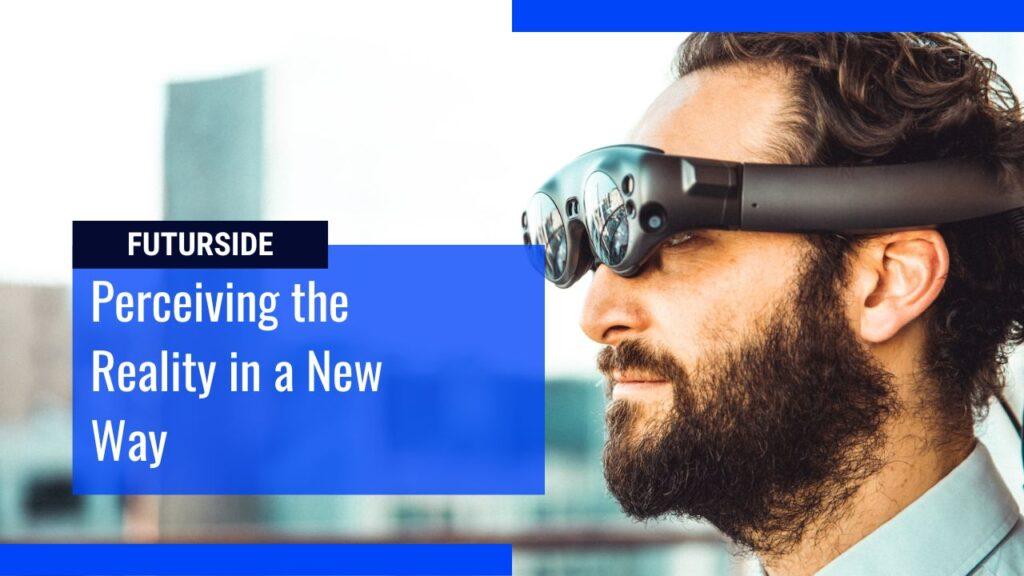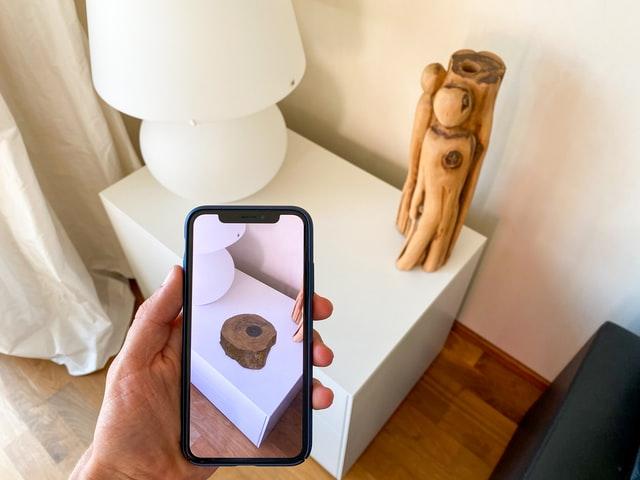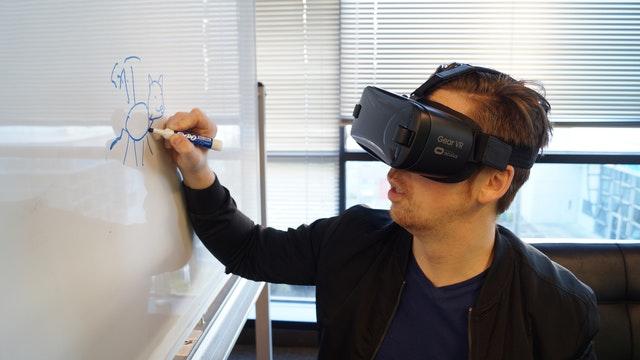When NASA build its Saturn five rockets in the 1960s to go to the moon, it used some of the most powerful computers that existed at the time. Fast forward to today, the smartphone in your pocket has more computing power than all the computers that NASA used for the Apollo Program.
NASA used computers to launch man onto the moon and we use all our computing power to launch Angry Birds at pigs in a virtual world. Technological advancement has brought us to an era where we can get to virtually any world without having to leave our house. A simple virtual reality gear can project our minds in different kinds of environments.
However, virtual reality only projects us to a virtual world, but what if we want to apply abstract ideas to the real world to augment it. We are now at a new dawn where the virtual world can meet with the physical world. Augmented Reality (AR) is creating a bridge between the physical world and abstract ideas.
AR gives the physical world the ability to apply pattern matching and develop an intuition around things and solve problems. Its main purpose is to enhance the real world with a set of magical virtual objects. When real environments are supplemented or augmented with computer-generated images then that’s an augmented reality
Games like Pokemon Go and Snapchat face filters are considered primitive forms of VR. So what exactly is augmented reality?

Contents
What is augmented reality?
Augmented reality is a technology that replaces a physical item with an image or information from another source. The idea of AR was conceived as early as the 1970s. In the United States, it was first used in sports, with the yellow first-down stripe on a gridiron football field. AR technology was later used to track golf balls and hockey pucks and the like.
Immersive AR overlays virtual objects over real-world elements. This type of AR creates convincing depth, perspective and other rendering characteristics by overlaying computer-generated elements over the real world. In addition to combining real and virtual objects, immersive technology can even add touch feedback to the real world.
In sci-fi movies, holograms are often created using this technique. Its technology is not yet fully developed, but smartphones already have processing capabilities. The first head-mounted displays were developed by Bob Sproull and Ivan Sutherland. Later, Myron Krueger developed a video place AR lab. He later applied the technology to cameras, projectors and silhouettes.
As technology continues to develop, AR devices can superimpose production or service instructions on real-world objects. Thousands of companies are already testing these devices in the field. Many are replacing traditional training methods and manuals with this new technology. And while AR is still in its early stages, it is already present in a wide variety of industries.
The technology is often used in business applications and events, but it has not yet reached mainstream popularity. The Pokemon GO application became a global phenomenon in 2016, boosting the technology’s popularity. Companies quickly realized that this technology had a great deal of potential for combining corporate and consumer tech.
Why augmented reality is gaining in importance?
Augmented reality is a growing technology that lets users superimpose digital images onto real objects. It works by using a camera to capture and project a 3D image onto a surface or object. In addition to creating interactive experiences, AR also improves the visual perception of people.

AR is increasingly being used in retail, as more people shop from the comfort of their homes. This technology can help consumers see the products they’re considering in their own homes, taking the guesswork out of purchasing. It also helps business professionals and employees master practical skills and practice new ones.
For businesses, AR can bring many new efficiencies. It can reduce costs associated with training, service, assembly, design and manufacturing. Companies can also eliminate the need for physical interfaces. It can improve performance across the entire value chain. In today’s highly competitive business environment, AR can be a huge boost for enterprises.
For example, the application Dulux Visualiser enables consumers to experience the color and texture of a room before they buy it. Augmented reality is a rapidly growing technology that lets consumers experience products in new ways. Some companies, such as Wayfair offer libraries of 3D product images to let consumers virtually try them before they buy.
While AR is making great strides in consumer markets, its effects are felt more profoundly in industrial settings. For example, at the end of the production process, engineers at Newport News Shipbuilding use AR to compare the actual ship with a complex 2D blueprint. By superimposing the final design on a 3D model of the ship, engineers can cut inspection time by 96%.
Augmented reality can help tourists learn more about the past or future. They can explore buildings built in the future or view historical events. Museums and educational institutions can also benefit from AR. For example, a traveler can explore a museum through its mobile application, which can show them everything from the exhibits to the history behind them.
In educational settings, AR can enhance classroom learning through interactive learning. It can even help students solve difficult homework problems. For example, students can use their mobile phone’s camera to aim at an awkward point in a mathematical equation and then watch a video explanation of the problem.
Another way it can transform learning is that it can change the location of classes and can even improve students understanding of concepts. It can also make learning easier and more engaging. Using AR in education can help students test their knowledge and develop their attitudes. The impact of augmented reality on human cognition is multifaceted.

AR technology is already affecting many fields, from the gaming industry to education. Pilot training, for example, is using AR to augment the real world. It has become a part of many current operations. The first application was developed in the 1990s for pilot training, since then, it has expanded into numerous fields. It can also aid military training and advanced navigation.
AR also opens up multiple differentiation paths. Companies can use AR to create companion experiences that extend the capabilities of their products. This can help them build customer loyalty because they can show off a product that works well with others. Companies like IKEA collects data on which products consumers prefer in different regions.
Likewise, AR can allow companies to improve or enhance existing products, which can also be a source of feedback for further opportunities for differentiation. It enables people to view 3D models on their mobile devices. These 3D models may include an animal, a museum, a natural site or even a chemical or rare compound.
In business, AR apps can help people visualize products and services. For example, the Wanna Kicks app allows users to virtually try on sneakers with 3D images. This is an excellent tool for businesses selling apparel. It can help customers make more informed decisions before purchasing. As a bonus, consumers will be able to see how well the shoes fit them before they buy them.
Google Translate is already using AR technology to translate foreign languages. Users can simply point their mobile camera at an unfamiliar alphabet and have the language displayed on their screen. Quiver, another AR-based app, transforms colored images into three-dimensional characters.
As AR gains adoption, it opens up new avenues for differentiation. Manufacturers can offer consumers extended product capabilities that give them more information or improve functionality. These experiences can increase product loyalty. In many cases, enhancing or improving a product’s functionality through AR can be a great differentiator.
The feedback generated from AR experiences can also be used to identify further differentiation opportunities. Magic Leap has spent $2.6 billion developing the technology. Other companies, such as TikTok, have even introduced AR effects to their videos. By allowing users to view branded 3D images of different body systems, AR is transforming user experiences.
One example of how AR has changed the way we see the world is in the workplace. Workers in warehouses and logistics can now read non-visible labels. A smart helmet with AR features can help workers navigate a worksite. It can also be used to project ancient civilizations over ruins to bring them to life.
The technology could be used to coordinate work activities and ensure quality. Further, it could be used to enhance promotional materials and train employees to solve complex work tasks. And there are several more uses for augmented reality. Some examples of augmented reality include construction safety, industrial training and virtual reality in healthcare.
Similarly, in the field of navigation, AR applications are becoming increasingly common. In fact, augmented reality is already being used in geography lessons. While museum visitors can view additional explanatory text about exhibits. Additionally, smaller-scale geographic applications allow users to communicate with two and three-dimensional objects directly.
The military industries invest enormous amounts of money in training personnel. AR could reduce these costs and make training more engaging. NASA’s Sidekick project is experimenting with Hololens and it can provide crew training with virtual illustrations and instructions. AR can even help soldiers see real-time information and reduce the chance of putting themselves in danger.
AR in marketing has the potential to improve the way people interact with products. With this technology, people can view information without being aware of the fact that it’s augmented. For one, it can enhance our perceptions of a brand, product or environment. Another impact of AR is on our self-image. People are increasingly relying on AR to improve their appearances.
Future of Augmented Reality
The future of augmented reality is incredibly exciting and the potential for its application is enormous. It can be used to instantly connect people, provide tools for businesses and industries and transform the way we interact with the real world. While the technology is still developing, experts are predicting that the expansion of 5G networks will make cloud-based AR experiences much easier to implement.
5G networks offer high-speed, low-latency internet, allowing users to access the world instantly or even create a digital twin. The world will soon be flooded with a world of augmented reality applications. From medical care to education, the possibilities are endless. Boeing has been using AR for several years to create circuit designs for aircraft models.
The benefits of augmented reality are immense. With more research and development, it is expected to be widely used in many sectors. This technology has the potential to improve outcomes in various industries. AR can be used for medical purposes. This technology is particularly useful for doctors and healthcare workers, as it can provide visual demonstrations and consumer scanning functionality.
For example, the healthcare industry has been ramping up AR use in the wake of a pandemic. While AR is not yet a perfect solution for patients, it can be used to improve the delivery of treatments and it can help doctors simulate procedures and medical students visualize anatomy. Medical professionals can use AR in many areas.
Doctors can view patient records digitally, eliminating the need for preliminary examinations. Nurses can also visualize veins with this technology. Medical education also benefits from the use of AR. It improves student interaction and practical discussions in class. Students can interact more with each other and better learn new things when they view virtual models in an AR environment.
AR technology is being used to enhance military skills and improve remote maintenance services. It can also help with navigation services in the dark. AR-powered earbuds are a great example of this technology. They add an augmented layer to real audio and can be customized to reduce background noise and other filters. This technology will make AR an even bigger part of our lives.
It’s no secret that students’ attention spans have shrunk. Some psychologists have found that students have a 10 to 15-minute attention span, while the average attention span in 2020 is less than 8 seconds. This is largely due to information overload and the constant ping of notifications. Augmented reality allows for a fully immersive experience that is relevant to the subject at hand.
A recent mobile app called Human Anatomy Atlas uses AR to help students learn about anatomy. The app includes a 3D model of the human body and information about different organs in different languages. AR can also be used in educational settings, such as field trips, to prepare future astronauts for space missions.
AR can make learning more effective in schools. By allowing students to see how different objects work in real life, teachers can observe how students respond. Students can even receive virtual scores based on how they perform during a class. Aside from making learning more interactive, AR can also improve the quality of life.
AR has many applications in the commercial world, including product visualization, virtual try-on, enhanced information and training. AR tools can help employees in a virtual environment, allowing them to learn while doing. It can also be used to teach people in hazardous or rare situations. Training people in the workplace through AR tools can help them develop skills that were otherwise impossible.
However, when using AR, it is important to take the time to understand how it affects human cognition. Narratives engage the entire brain and help us understand more about our actions. Because stories engage all levels of our brains, they have the potential to be more persuasive than the rest of us. So, it’s important to understand how AR affects our thinking, mental health and how we engage with it.
While a lot of businesses are already experimenting with AR, this technology still has a way to go before reaching the consumer market. The company zSpace, uses the technology to allow users to see 3D objects. In addition, the company Meta which started a Kickstarter campaign is working on a Glass-like device to display text and images in conjunction with a smartphone.
Another company, NVIDIA, has developed a Glass-like product with OLED micro-displays that can show data in real-time. With this advancement, the future of augmented reality looks incredibly promising. AR glasses could be used to show directions, preview furniture or check out a new house.
Doctors could even view the vitals of a patient using these glasses. It’s only a matter of time before these glasses become commonplace. A good way to make AR more useful is to integrate it with machine learning, augmented intelligence and artificial intelligence. But until that day comes, this technology still has much to offer.

0 Comments